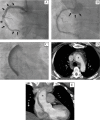Conservative Management of Extensive Iatrogenic Aortic Dissection
- PMID: 28516099
- PMCID: PMC5425260
- DOI: 10.12945/j.aorta.2016.16.040
Conservative Management of Extensive Iatrogenic Aortic Dissection
Abstract
Iatrogenic aortic dissection (IAD) is a rare complication of percutaneous coronary interventions (PCI). There are no clear guidelines for IAD management, and limited data are available. Registry data and case series combined with extrapolations from our experience with spontaneous Type-A dissections suggest that very limited dissections are often managed conservatively with coronary stenting of the entry tear when possible, while more extensive dissections are managed surgically. We present a case report of a 50-year-old woman who underwent PCI for an ST-elevation myocardial infarction that resulted in an extensive IAD from the ostium of the right coronary artery to the aortic root, ascending aorta, and aortic arch. While the current evidence strongly supports surgical management of such extensive dissection, our patient was successfully managed conservatively with complete resolution according to short-term computed tomography imaging. This case suggests that conservative management may be a reasonable approach for select patients with extensive IAD.
Keywords: Iatrogenic aortic dissection; Percutaneous coronary intervention.
Figures


Similar articles
-
[Iatrogenic dissection of the right coronary artery and the ascending aorta during coronary intervention].Ann Cardiol Angeiol (Paris). 2010 Jun;59(3):168-71. doi: 10.1016/j.ancard.2009.05.001. Epub 2009 Jun 9. Ann Cardiol Angeiol (Paris). 2010. PMID: 20003961 French.
-
Iatrogenic Acute Ascending Aortic Dissection with Intramural Hematoma during Coronary Artery Stenting: A Case Report.Front Surg. 2017 Feb 3;4:2. doi: 10.3389/fsurg.2017.00002. eCollection 2017. Front Surg. 2017. PMID: 28217690 Free PMC article.
-
Successful Aorta-osteal Stenting after Iatrogenic Acute Type-A Aortic Dissection during Primary Percutaneous Coronary Intervention.Balkan Med J. 2014 Dec;31(4):352-5. doi: 10.5152/balkanmedj.2014.14039. Epub 2014 Dec 1. Balkan Med J. 2014. PMID: 25667792 Free PMC article.
-
Spontaneous retrograde dissection of ascending aorta from descending thoracic aorta--a case review.Perfusion. 2011 May;26(3):215-22. doi: 10.1177/0267659110395804. Epub 2011 Jan 19. Perfusion. 2011. PMID: 21247986 Review.
-
Aortocoronary dissection complicating a percutaneous coronary intervention.J Invasive Cardiol. 2003 Feb;15(2):89-92. J Invasive Cardiol. 2003. PMID: 12556623 Review.
Cited by
-
Successful conservative management of Class III iatrogenic aortic dissection.J Geriatr Cardiol. 2018 Mar;15(3):235-237. doi: 10.11909/j.issn.1671-5411.2018.03.006. J Geriatr Cardiol. 2018. PMID: 29721003 Free PMC article. No abstract available.
-
Outcome after Surgery for Iatrogenic Acute Type A Aortic Dissection.J Clin Med. 2022 Nov 14;11(22):6729. doi: 10.3390/jcm11226729. J Clin Med. 2022. PMID: 36431205 Free PMC article.
-
Iatrogenic Aortocoronary Dissection During Right Coronary Artery Procedures: A Systematic Review of the Published Literature.J Soc Cardiovasc Angiogr Interv. 2022 Aug 27;1(6):100443. doi: 10.1016/j.jscai.2022.100443. eCollection 2022 Nov-Dec. J Soc Cardiovasc Angiogr Interv. 2022. PMID: 39132357 Free PMC article. Review.
-
Iatrogenic Aortic Dissection: Review of the Literature.Aorta (Stamford). 2016 Dec 1;4(6):240-243. doi: 10.12945/j.aorta.2016.16.081. eCollection 2016 Dec. Aorta (Stamford). 2016. PMID: 28516102 Free PMC article. No abstract available.
References
-
- Núñez-Gil IJ, Bautista D, Cerrato E, Salinas P, Varbella F, Omedè P, et al. . Incidence, management, and immediate- and long-term outcomes after iatrogenic aortic dissection during dagnostic or interventional coronary procedures. Circulation. 2015;131:2114-2119. DOI: 10.1161/CIRCULATIONAHA.115.015334 - DOI - PubMed
Publication types
LinkOut - more resources
Full Text Sources
Other Literature Sources
Miscellaneous

